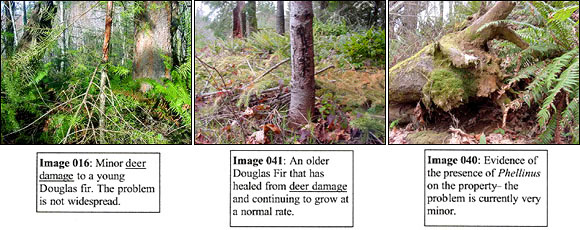Forest Stewardship Plan
5.1 Forest Health
The overall health of this forest is good with no problems posing significant threats at this time. However there are four minor threats to forest health that the landowner and I have identified: root rot, noxious weeds, animal damage, and fire.
Noxious weeds: The overall threat posed by noxious weeds is low. Invasive species present on the property are Himalayan and Evergreen Blackberry (Rubus discolor, Rubus laciniatus), English Ivy (Hedera helix), and English Holly (Ilex aquifolium).
Animal Damage: Animal damage to the forest is low. There is minor evidence of deer (Odocoileus hemionus) and bear (Ursus americanus) damage.
Root Rot: (Phellinus weirii) Root rot is evident in small amounts on the property.
Fire: Fire is rare in the area and not intended for use as a management tool. Risk of fire is low. The primary area of concern is on the west side of the property in the area most affected by the ice storm. There is a significant amount of downed woody debris and snags in this area.
Enhancement and Protection
Noxious Weeds: Chemical control of noxious weeds is not consistent with the landowner’s objectives.
- Himalayan Blackberry and Evergreen Blackberry (Image 024): The blackberry damage level is low. The majority is being shaded out as the canopy develops late sucessional characteristics. Physical control has been the main method pursued, entailing pulling the weeds by hand which minimizes damage to surrounding vegetation. It is pursued on a continual basis. The weeds are left on site, and because of the preference of the landowner to manage during winter, the likelihood of reseeding is low. When left in piles they will decompose naturally and provide wildlife habitat.
I would recommend that if Rubus discolor is eradicated in spring and there is evidence of berries that the vines be removed and burned.
- English Ivy (Image 009): The level of English ivy damage is low. Physical control has been the main maintenance method pursued: the vines are cut and piled, reducing the propensity of rerooting.
I would recommend that if English ivy appears to be rerooting it be removed from the site. The English Ivy in the meadow edge should be treated in the next two years before it becomes a problem.
- English Holly (Image 028): The level of holly damage is low. The current management method pursued is to let the larger individuals continue to grow and pull the smaller individuals and leave them on site.
I recommend that the current management method be continued and the landowners continue to monitor the larger holly trees for increasing damage. If damage becomes evident I recommend they be removed.

Animal Damage: Animal damage control through chemicals is not consistent with landowner objectives.
- Deer (Image 016, 041): There is evidence of deer damage on a small amount young Douglas fir. The damage consists of both browse to the foliage and damage to the trunk from young deer rubbing their antlers against the stem during molting season. No management method has been pursued as the trees have evidenced significant terminal growth post damage.
I would recommend management methods be researched if the damage becomes a growth-inhibiting factor for effected species.
- Bear: There has been minor evidence of bear damage to Douglas fir, as the cubs derive sugar and other nutrients from the sap. The damage is minor and at this time does not need to be addressed. If the problem persists I recommend that methods of control be researched.

Root Rot: (Image 40) Root rot is a minor problem on the property. Because it affects young Douglas fir, a relatively minor species on the property, the risk of widespread destruction is low.
I recommend continued monitoring of root rot, isolation of areas including infected stumps when practical, and continuing to underplant Western red cedar, a root rot resistant species. If the problem becomes widespread I recommend alternative management methods be researched.
Fire: While there is a significant amount of downed wood in the forest, it does not pose a significant fire threat. Stands have been thinned, decreasing the chances of fire spreading. Limbing has been done to prevent fire ladders from allowing fire to creep into the forest canopy.
Home Fire Safety Checklist
- Trees and brush are properly thinned and pruned within 50 feet of all structures. Western red cedar (Thuja plicata) near the main house have been limbed, which are the only trees near any structure. No trees are planted near the structures.
- The roof and gutter are cleared of debris twice annually.
- Grass and weeds are cut within 10 feet of all structures on a weekly basis.
- Firewood is stacked away from the house in the barn.
- There is an outdoor water supply available.
- The fire extinguisher has been checked and is functional.
- There is good access to the home site by a fire truck.
- There is a load limit posted in front of the bridge, there is a sign posted for property identification and there is ample vehicle parking.
- There are fire tools available.
- There is a family fire drill and it has been practiced.
- The home is in a fire district.
|


